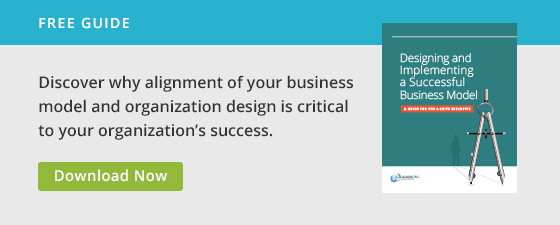A change partner is essential when developing your business model and organization design because they can bring methodologies and tools needed to guide the work. Your change partner could be an HR manager or some other internal resource. But, it may be better to factor in partners outside the organization for your change transformation.
External partners may be able to bring a clearer perspective of your organization than those who have a shared history with your business. The presence of an external change partner can also bring others into the discussion and smooth the path to consensus.
An effective outside firm can help your organization work through the process of organizational alignment, asking the questions that lead to the best solutions. Only then will you be able to come up with a strategy, a business model, and an organization design and facilitate implementation that leads to true transformational change. Some of the qualities of an effective transformation partner include the following:
- Is objective. An external partner should not come in with a preconceived agenda for your organization. They also should not come in ready with the answers or even a specific viewpoint. If they do, you’ll likely end up with a business model that may not be what you need. Remember, the alignment process is what leads to answers and solutions, not the other way around.
- Asks tough questions. Nothing that was ever worthwhile was easy. Objectivity allows a change partner to ask the tough questions. Sometimes, there are ingrained assumptions that need to be challenged. Internal stakeholders may not think to challenge those assumptions or worse may shy away because of the political implications. It is exactly those tough questions that need to be asked. It’s the only way you’ll find out what you really need to do when embarking on change transformation.
- Can help you work through the process more efficiently. A good change partner will have deep experience working with organizations to create and implement a business model and align organizational choices. They’ll have a track record of success, too. This expertise will pave the way for more efficient development and implementation.
- Provides a balcony viewpoint. Being a good alignment leader or Chief Alignment Officer (CAO) isn’t easy. You need a big-picture perspective. An outside firm can help you step back so you can see the big picture—it is an invaluable quality. Seeing the interconnectedness of your organization’s choices is key to making good design choices.
- Can build capabilities effectively. A good external partner can transfer tools and methods the organization needs to examine its design choices. To build the necessary skills, business leaders and change partners must learn how to tackle organization alignment questions in a logical manner, so having a toolset is key. Also, leaders and internal change partners need to learn how to help others in the organization embrace the alignment leader role. Your team can’t assume model behaviors if you and your team aren’t teaching and exhibiting them.
Over the last 2 years, we’ve trained hundreds of practitioners throughout the world to assume the alignment leader role. For instance, a global manufacturer that brought AlignOrg Solutions in to redesign one function in their business had fragmented resources, which left them ineffective in many areas beyond what we were asked to assess. Rather than fixing one function, we helped them develop a better operating model—a macro design (see our blog, “Ensuring Organization Design Effectiveness When Implementing Organizational Change”).
Not only have we helped the organization facilitate change transformation but also develop skills so the organization can carry forward and sustain the changes. We offered a holistic approach to organizational alignment and change transformation that helps organizations work through the process efficiently.
An objective change agent will ask the questions you may be overlooking. But sometimes only a holistic, outside perspective will bring about the change transformation your organization needs to move forward and grow.






